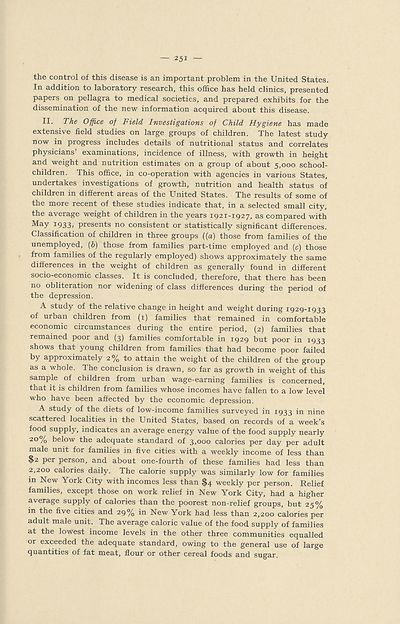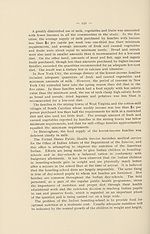Download files
Complete book:
Individual page:
Thumbnail gallery: Grid view | List view

— 251
the control of this disease is an important problem in the United States.
In addition to laboratory research, this office has held clinics, presented
papers on pellagra to medical societies, and prepared exhibits for the
dissemination of the new information acquired about this disease.
II. The Office of Field Investigations of Child Hygiene has made
extensive field studies on large groups of children. The latest study
now in progress includes details of nutritional status and correlates
physicians examinations, incidence of illness, with growth in height
and weight and nutrition estimates on a group of about 5,000 school-
children. This office, in co-operation with agencies in various States,
undertakes investigations of growth, nutrition and health status of
children in different areas of the United States. The results of some of
the more recent of these studies indicate that, in a selected small city,
the average weight of children in the years 1921-1927, as compared with
May 1933, presents no consistent or statistically significant differences.
Classification of children in three groups ((a) those from families of the
unemployed, [b) those from families part-time employed and (c) those
from families of the regularly employed) shows approximately the same
differences in the weight of children as generally found in different
socio-economic classes. It is concluded, therefore, that there has been
no obliteration nor widening of class differences during the period of
the depression.
A study of the relative change in height and weight during 1929-1933
of urban children from (1) families that remained in comfortable
economic circumstances during the entire period, (2) families that
remained poor and (3) families comfortable in 1929 but poor in 1933
shows that young children from families that had become poor failed
by approximately 2% to attain the weight of the children of the group
as a whole. The conclusion is drawn, so far as growth in weight of this
sample of children from urban wage-earning families is concerned,
that it is children from families whose incomes have fallen to a low level
who have been affected by the economic depression.
A study of the diets of low-income families surveyed in 1933 in nine
scattered localities in the United States, based on records of a week’s
food supply, indicates an average energy value of the food supply nearly
20% below the adequate standard of 3,000 calories per day per adult
male unit for families in five cities with a weekly income of less than
$2 per person, and about one-fourth of these families had less than
2,200 calories daily. The calorie supply was similarly low for families
in New York City with incomes less than $4 weekly per person. Relief
families, except those on work relief in New York City, had a higher
average supply of calories than the poorest non-relief groups, but 25%
in the five cities and 29% in New York had less than 2,200 calories per
adult male unit. The average caloric value of the food supply of families
at the lowest income levels in the other three communities equalled
or exceeded the adequate standard, owing to the general use of large
quantities of fat meat, flour or other cereal foods and sugar.
the control of this disease is an important problem in the United States.
In addition to laboratory research, this office has held clinics, presented
papers on pellagra to medical societies, and prepared exhibits for the
dissemination of the new information acquired about this disease.
II. The Office of Field Investigations of Child Hygiene has made
extensive field studies on large groups of children. The latest study
now in progress includes details of nutritional status and correlates
physicians examinations, incidence of illness, with growth in height
and weight and nutrition estimates on a group of about 5,000 school-
children. This office, in co-operation with agencies in various States,
undertakes investigations of growth, nutrition and health status of
children in different areas of the United States. The results of some of
the more recent of these studies indicate that, in a selected small city,
the average weight of children in the years 1921-1927, as compared with
May 1933, presents no consistent or statistically significant differences.
Classification of children in three groups ((a) those from families of the
unemployed, [b) those from families part-time employed and (c) those
from families of the regularly employed) shows approximately the same
differences in the weight of children as generally found in different
socio-economic classes. It is concluded, therefore, that there has been
no obliteration nor widening of class differences during the period of
the depression.
A study of the relative change in height and weight during 1929-1933
of urban children from (1) families that remained in comfortable
economic circumstances during the entire period, (2) families that
remained poor and (3) families comfortable in 1929 but poor in 1933
shows that young children from families that had become poor failed
by approximately 2% to attain the weight of the children of the group
as a whole. The conclusion is drawn, so far as growth in weight of this
sample of children from urban wage-earning families is concerned,
that it is children from families whose incomes have fallen to a low level
who have been affected by the economic depression.
A study of the diets of low-income families surveyed in 1933 in nine
scattered localities in the United States, based on records of a week’s
food supply, indicates an average energy value of the food supply nearly
20% below the adequate standard of 3,000 calories per day per adult
male unit for families in five cities with a weekly income of less than
$2 per person, and about one-fourth of these families had less than
2,200 calories daily. The calorie supply was similarly low for families
in New York City with incomes less than $4 weekly per person. Relief
families, except those on work relief in New York City, had a higher
average supply of calories than the poorest non-relief groups, but 25%
in the five cities and 29% in New York had less than 2,200 calories per
adult male unit. The average caloric value of the food supply of families
at the lowest income levels in the other three communities equalled
or exceeded the adequate standard, owing to the general use of large
quantities of fat meat, flour or other cereal foods and sugar.
Set display mode to:
![]() Universal Viewer |
Universal Viewer | ![]() Mirador |
Large image | Transcription
Mirador |
Large image | Transcription
Images and transcriptions on this page, including medium image downloads, may be used under the Creative Commons Attribution 4.0 International Licence unless otherwise stated. ![]()
| League of Nations > Economic and financial section > Problem of nutrition > (253) |
|---|
| Permanent URL | https://digital.nls.uk/190927051 |
|---|
| Shelfmark | LN.II |
|---|
| Description | Over 1,200 documents from the non-political organs of the League of Nations that dealt with health, disarmament, economic and financial matters for the duration of the League (1919-1945). Also online are statistical bulletins, essential facts, and an overview of the League by the first Secretary General, Sir Eric Drummond. These items are part of the Official Publications collection at the National Library of Scotland. |
|---|---|
| Additional NLS resources: |
|

